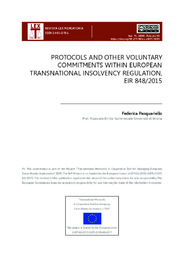Please use this identifier to cite or link to this item:
https://hdl.handle.net/11000/5242Full metadata record
| DC Field | Value | Language |
|---|---|---|
| dc.contributor.author | Pasquariello, Federica | - |
| dc.contributor.other | Departamentos de la UMH::Ciencia Jurídica | es |
| dc.date.accessioned | 2019-07-18T07:37:11Z | - |
| dc.date.available | 2019-07-18T07:37:11Z | - |
| dc.date.created | 2019-01 | - |
| dc.date.issued | 2019-07-18 | - |
| dc.identifier.issn | 2445-0936 | - |
| dc.identifier.uri | http://hdl.handle.net/11000/5242 | - |
| dc.description.abstract | In response to cross-border insolvencies, conflicts of law and jurisdiction may arise and they cannot be resolved in a strictly Territorial approach. In fact, in an era of globalized and interconnected economies, an insolvency proceeding on a narrow national basis, which coexists with at least one other local proceeding may lead to unexpected outcomes. Actually, under Territorialism, each Country seizes the debtor’s assets which are located within its borders and conducts a separate bankruptcy proceeding to divide those assets among local creditors according to local law, while no proceeding affects each other. This causes a sharp fragmentation of the active and passive masses, and produces disappointing effects both on the level of creditors’ recovery, and on the front of an increase of costs as well. | es |
| dc.format | application/pdf | es |
| dc.format.extent | 6 | es |
| dc.language.iso | eng | es |
| dc.rights | info:eu-repo/semantics/openAccess | es |
| dc.subject | territorialismo | es |
| dc.subject | insolvencias transfronterizas | es |
| dc.subject.other | CDU::3 - Ciencias sociales: 34 - Derecho | es |
| dc.title | Protocols and other voluntary commitments within european transnational insolvency regulation, EIR 848/2015 | es |
| dc.type | info:eu-repo/semantics/article | es |

View/Open:
1659-4850-2-PB.pdf
159,16 kB
Adobe PDF
Share:
.png)
